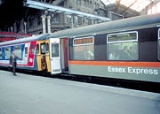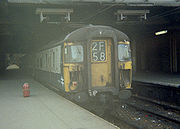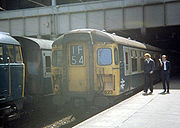
British Rail Class 309
Encyclopedia


British Rail
British Railways , which from 1965 traded as British Rail, was the operator of most of the rail transport in Great Britain between 1948 and 1997. It was formed from the nationalisation of the "Big Four" British railway companies and lasted until the gradual privatisation of British Rail, in stages...
Class 309 "Clacton Express" electric multiple unit
Electric multiple unit
An electric multiple unit or EMU is a multiple unit train consisting of self-propelled carriages, using electricity as the motive power. An EMU requires no separate locomotive, as electric traction motors are incorporated within one or a number of the carriages...
s (EMUs) were built by British Rail (BR) York
York
York is a walled city, situated at the confluence of the Rivers Ouse and Foss in North Yorkshire, England. The city has a rich heritage and has provided the backdrop to major political events throughout much of its two millennia of existence...
Works from 1962-1963. They were initially classified as Class AM9 before the introduction of TOPS
TOPS
Total Operations Processing System, or TOPS, is a computer system for managing the locomotives and rolling stock owned by a rail system...
. These units were the first express 25 kV
Volt
The volt is the SI derived unit for electric potential, electric potential difference, and electromotive force. The volt is named in honor of the Italian physicist Alessandro Volta , who invented the voltaic pile, possibly the first chemical battery.- Definition :A single volt is defined as the...
alternating current
Alternating current
In alternating current the movement of electric charge periodically reverses direction. In direct current , the flow of electric charge is only in one direction....
(AC) units to be built by British Rail, and British Rail's first EMUs to be capable of 100 mph.
Description
Twenty-three units were built in three different batches.- 601-608 - Two-car units
- 611-618 - Four-car units containing a griddle car
- 621-627 - Four-car units
Each unit had identical electrical equipment. The original concept called for increasing the power-to-weight ratio when strengthening trains from eight to ten cars in peak periods using the 2-car units, in order to make the peak timetable more resilient.
Operations
When built, units were used exclusively on Great Eastern Main LineGreat Eastern Main Line
The Great Eastern Main Line is a 212 Kilometre major railway line of the British railway system, which connects Liverpool Street in the City of London with destinations in east London and the East of England, including Chelmsford, Colchester, Ipswich, Norwich and several coastal resorts such as...
(GEML) express services from London Liverpool Street to Clacton-on-Sea
Clacton-on-Sea
Clacton-on-Sea is the largest town on the Tendring peninsula, in Essex, England and was founded in 1871. It is a seaside resort that attracted many tourists in the summer months between the 1950s and 1970s, but which like many other British sea-side resorts went into decline as a holiday...
and Walton-on-the-Naze
Walton-on-the-Naze
Walton-on-the-Naze is a small town in Essex, England, on the North Sea coast in the Tendring district. It is north of Clacton and south of the port of Harwich. It abuts Frinton-on-Sea to the south, and is part of the parish of Frinton and Walton. It is a resort town, with a permanent population of...
. Trains would be formed of three units in a ten-car formation (i.e. one two car unit, and two four car units). The train would divide at Thorpe-le-Soken
Thorpe-le-Soken
Thorpe-le-Soken is a village in Essex, located west of Walton-on-the-Naze, Frinton-on-Sea and north of Clacton-on-Sea.-History:Thorpe-le-Soken's history can be traced back to Saxon times....
, with one of the 4-cars units used on the Walton section, and the remaining six cars continuing to Clacton. The Walton portion usually comprised the griddle car unit.
This continued until the late 1970s, when many of the units were reformed. The two-car units were augmented to four-car units between 1977 and 1980, with the addition of converted former locomotive-hauled coaching stock. In 1980, the griddle cars were taken out of use, reducing units 611-618 to 3-car units. They were later augmented to 4-car units during the refurbishment work.
The entire fleet was refurbished in the period 1985-1987. The first units outshopped were painted in the bold new London and SouthEastern
Network SouthEast
Network SouthEast was one of three passenger sectors of British Rail created in 1982. NSE principally operated commuter trains in the London area and inter-urban services in densely populated South East England, although the network reached as far west as Exeter...
"Jaffa Cake" livery. However, this was soon superseded by the equally bold Network SouthEast
Network SouthEast
Network SouthEast was one of three passenger sectors of British Rail created in 1982. NSE principally operated commuter trains in the London area and inter-urban services in densely populated South East England, although the network reached as far west as Exeter...
livery, which was introduced in 1986. Coinciding with the refurbishment work, in 1985 electrification spread north from Colchester
Colchester
Colchester is an historic town and the largest settlement within the borough of Colchester in Essex, England.At the time of the census in 2001, it had a population of 104,390. However, the population is rapidly increasing, and has been named as one of Britain's fastest growing towns. As the...
to Ipswich
Ipswich
Ipswich is a large town and a non-metropolitan district. It is the county town of Suffolk, England. Ipswich is located on the estuary of the River Orwell...
, and later to Harwich
Harwich
Harwich is a town in Essex, England and one of the Haven ports, located on the coast with the North Sea to the east. It is in the Tendring district. Nearby places include Felixstowe to the northeast, Ipswich to the northwest, Colchester to the southwest and Clacton-on-Sea to the south...
and Norwich
Norwich
Norwich is a city in England. It is the regional administrative centre and county town of Norfolk. During the 11th century, Norwich was the largest city in England after London, and one of the most important places in the kingdom...
. This meant the Class 309 units were soon introduced on fast trains to Ipswich and Harwich.
In 1989, new Class 321/3
British Rail Class 321
The British Rail Class 321 alternating current electric multiple units were built by BREL York in three batches from 1988-91. The design was successful and led to the development of the similar Class 320 and Class 322 units for use by Strathclyde PTE and Stansted Express respectively...
units were introduced onto GEML services partially replacing both class 309 and Class 312
British Rail Class 312
The British Rail Class 312 is a type of alternating current electric multiple unit built in 1975-1978 for use on outer-suburban passenger services. It was the last class of multiple unit to be constructed with the British Rail Mark 2 bodyshell, and also the last with slam doors...
diagrams. The "Clacton Express" units however continued until May 1992 in main service and then a reduced fleet operated a few rush hour services until January 1994. The last units were withdrawn on 22 January 1994, despite their recent and expensive refurbishment. After working a final railtour (15 January 1994) and the week of normal services a final Saturday diagram was run with 309626/613/616 ending on the 1800 Liverpool Street
Liverpool Street
Liverpool Street can refer to:*Liverpool Street station, a major mainline railway station in Central London, England*Liverpool Street, Hobart, a major street in the Hobart city centre....
- Clacton. However, not all units were immediately scrapped, and seven were retained for possible reuse around Manchester
Manchester
Manchester is a city and metropolitan borough in Greater Manchester, England. According to the Office for National Statistics, the 2010 mid-year population estimate for Manchester was 498,800. Manchester lies within one of the UK's largest metropolitan areas, the metropolitan county of Greater...
on suburban trains. These units were stored at Blackpool
Blackpool
Blackpool is a borough, seaside town, and unitary authority area of Lancashire, in North West England. It is situated along England's west coast by the Irish Sea, between the Ribble and Wyre estuaries, northwest of Preston, north of Liverpool, and northwest of Manchester...
.
In 1994, Regional Railways
Regional Railways
Regional Railways was one of the three passenger sectors of British Rail created in 1982 that existed until 1996, 3 years after privatisation. The sector was originally called Provincial....
North West (RRNW) acquired the seven redundant units stored at Blackpool. The units, nos. 309613/616/617/624/626/627, were quickly put to use on suburban passenger services from Manchester Piccadilly to Crewe
Crewe
Crewe is a railway town within the unitary authority area of Cheshire East and the ceremonial county of Cheshire, England. According to the 2001 census the urban area had a population of 67,683...
and Stoke-on-Trent
Stoke-on-Trent
Stoke-on-Trent , also called The Potteries is a city in Staffordshire, England, which forms a linear conurbation almost 12 miles long, with an area of . Together with the Borough of Newcastle-under-Lyme Stoke forms The Potteries Urban Area...
. Six of the units were repainted in RRNW blue livery with a green stripe. The seventh, no. 309624, was repainted in a special blue livery to commemorate the opening a new railway line to Manchester International Airport in 1996. Upon privatisation, the units passed to the North Western Trains (NWT) franchise. This was later renamed First North Western
First North Western
First North Western was a train operating company in the United Kingdom serving North West England. It operated from 1997 to 2004.The company when first privatised was known as North Western Trains and was owned by Great Western Holdings, a partnership between Great Western's management, First...
(FNW) following First Group's take-over of the franchise.
By the late 1990s, the seven units saw continued use around Manchester. They also saw some use on longer distance services, with one booked daily Manchester Piccadilly-Birmingham International
Birmingham International
Birmingham International may refer to:* Birmingham International railway station, Birmingham, England* Birmingham International Airport , serving Birmingham, England* Birmingham-Shuttlesworth International Airport, serving Birmingham, Alabama...
service and return. On occasion, units were used on NWT's Manchester-London Euston service, deputising for a non-available Class 322
British Rail Class 322
The British Rail Class 322 electric multiple units were built by BREL in 1990. Five 4-car units were built for the dedicated Stansted Express service from London Liverpool Street to Stansted Airport. The units were then used by First ScotRail, operating on the North Berwick Branch Line, between /...
unit. At one point, it was planned to use the units on a new Crewe
Crewe
Crewe is a railway town within the unitary authority area of Cheshire East and the ceremonial county of Cheshire, England. According to the 2001 census the urban area had a population of 67,683...
- stopping service, but this did not happen. However, the end was in sight, because as part of their franchise commitment, FNW had to replace their slam-door rolling stock, including the Class 309 units. New Class 175
British Rail Class 175
The Class 175 Coradia is a type of diesel multiple unit passenger train used in the United Kingdom. The fleet of 27 sets were built from 1999 to 2001 by Alstom at Washwood Heath in Birmingham. They are part of the Coradia family of trains along with the Class 180.The entire fleet is owned by the...
diesel multiple unit
Diesel multiple unit
A diesel multiple unit or DMU is a multiple unit train consisting of multiple carriages powered by one or more on-board diesel engines. They may also be referred to as a railcar or railmotor, depending on country.-Design:...
s were introduced in 1999-2000, and FNW discontinued its Manchester-Euston service. This meant that the "Clacton Express" units were surplus to requirements. As a farewell gesture, three units were used on a final railtour from Manchester to their old haunt of Clacton-on-Sea
Clacton-on-Sea
Clacton-on-Sea is the largest town on the Tendring peninsula, in Essex, England and was founded in 1871. It is a seaside resort that attracted many tourists in the summer months between the 1950s and 1970s, but which like many other British sea-side resorts went into decline as a holiday...
via London Liverpool Street. Following this tour, all seven units were withdrawn in late 2000, and sent for storage at MoD Pig's Bay near Shoeburyness
Shoeburyness
Shoeburyness is a town in southeast Essex, England, situated at the mouth of the river Thames Estuary. It is within the borough of Southend-on-Sea, and is situated at the far east of the borough, around east of Southend town centre...
. Two of the units later saw further use in departmental service, whilst the remaining five were scrapped in 2004.
Further use
Following withdrawal from normal service, two units were convered to Class 960 departmental units in 2001 for further use as cab-signalling test units. The two units concerned were reduced in length to 3-car units, and were based at the test track at Old Dalby in LeicestershireLeicestershire
Leicestershire is a landlocked county in the English Midlands. It takes its name from the heavily populated City of Leicester, traditionally its administrative centre, although the City of Leicester unitary authority is today administered separately from the rest of Leicestershire...
. Both units were painted in a blue and white livery.
- 960101 (ex-309616) - named "West Coast Flyer"
- 960102 (ex-309624) - named "New Dalby"
They were withdrawn in 2004 following completion of the tests. Both where stored at MoD Pig's Bay, near Shoeburyness
Shoeburyness
Shoeburyness is a town in southeast Essex, England, situated at the mouth of the river Thames Estuary. It is within the borough of Southend-on-Sea, and is situated at the far east of the borough, around east of Southend town centre...
, Essex
Essex
Essex is a ceremonial and non-metropolitan county in the East region of England, and one of the home counties. It is located to the northeast of Greater London. It borders with Cambridgeshire and Suffolk to the north, Hertfordshire to the west, Kent to the South and London to the south west...
, until early 2009 when they finally entered preservation.
Preservation
- 960101 (ex-309616) - Electric Railway Museum, BagintonCoventry Railway CentreThe Electric Railway Museum is located in Warwickshire, south of Coventry city, outside Baginton, and near to Coventry Airport. The heritage railway centre was also known as "The Airfield Line" as the railway was built on the site of a greenfield...
- 960102 (ex-309624) - Electric Railway Museum, BagintonCoventry Railway CentreThe Electric Railway Museum is located in Warwickshire, south of Coventry city, outside Baginton, and near to Coventry Airport. The heritage railway centre was also known as "The Airfield Line" as the railway was built on the site of a greenfield...

